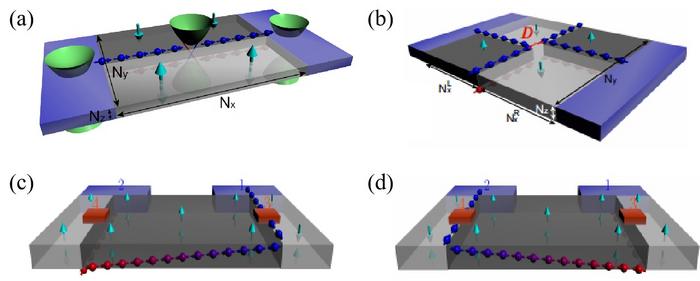Based upon the basic principles of quantum mechanics, researchers have been able to design and fabricate electronic devices with specialized functionalities by manipulating the internal degrees of freedom of charge carriers to regulate the transport behavior. These quantum electronic devices have surpassed the performance of traditional semiconductor devices in terms of information storage, processing, and transmission, with significant advantages of lower energy consumption and higher efficiency. At present, spintronics and valleytronics are two scenarios to construct quantum electronic devices by manipulating the spin and valley degrees of freedom, respectively, showing great potentials in the fields of low energy-consumption devices and quantum computing. Even though, spintronics and valleytronics still have limitations. In spintronics, the Datta-Das spin field effect transistor that achieves spin polarization reversal by controlling the current has not been successfully prepared due to technical shortages. In valleytronics, there is still no effective method to realize complete reversal of valley polarization between two energy valleys. Therefore, it is a widely concerned issue to find a new degree of freedom beyond spin and valley to establish corresponding transport mechanism and build higher-performance electronic devices.

Credit: ©Science China Press
Based upon the basic principles of quantum mechanics, researchers have been able to design and fabricate electronic devices with specialized functionalities by manipulating the internal degrees of freedom of charge carriers to regulate the transport behavior. These quantum electronic devices have surpassed the performance of traditional semiconductor devices in terms of information storage, processing, and transmission, with significant advantages of lower energy consumption and higher efficiency. At present, spintronics and valleytronics are two scenarios to construct quantum electronic devices by manipulating the spin and valley degrees of freedom, respectively, showing great potentials in the fields of low energy-consumption devices and quantum computing. Even though, spintronics and valleytronics still have limitations. In spintronics, the Datta-Das spin field effect transistor that achieves spin polarization reversal by controlling the current has not been successfully prepared due to technical shortages. In valleytronics, there is still no effective method to realize complete reversal of valley polarization between two energy valleys. Therefore, it is a widely concerned issue to find a new degree of freedom beyond spin and valley to establish corresponding transport mechanism and build higher-performance electronic devices.
A recent experimental study reported an anomalous layer-polarized Hall effect realized in the intrinsic antiferromagnetic axion insulator (AI) material MnBi2Te4 [Nature 595, 521 (2021)]. This progress has made people realize that, besides spin and valley, the spatial degree of freedom of electrons (here referring to layer degree of freedom) can also be flexibly controlled, which is expected to be utilized to construct new electronic devices. However, the layer-polarized charge transport is not topologically protected, and has no significant advantages in terms of energy loss and working efficiency. Therefore, whether the layer degree of freedom can be manipulated dissipationlessly using topologically protected elementary excitations is a key issue to be solved in the preparation of high-performance devices in layer electronics.
Recently, the research team led by Professor X. C. Xie and Professor Hua Jiang from Interdisciplinary Center for Theoretical Physics and Information Sciences at Fudan University/International Center for Quantum Materials at Peking University has conducted theoretical research on the design of layertronics devices in the AI MnBi2Te4. This study has established the concept of “layertronics” and designed prototype devices of layer filters, layer valves, and layer reversers using layer-polarized chiral topological domain wall modes in MnBi2Te4 materials. Compared to spintronics and valleytronics, layertronics devices are more stable and have lower energy consumption, which can be used for information encoding, processing, and storage. They are feasible solutions for fabricating new generation of electronic devices with high-efficiency and low dissipation. This work has been published in the issue 11 of National Science Review in 2024, titled “Dissipationless layertronics in axion insulator MnBi2Te4“. Professor Jiang Hua from Fudan University and Postdoctoral Fellow Gong Ming from Peking University’s Boya Postdoctoral Program are the co-corresponding authors, while Gong Ming and Postdoctoral Fellow Li Shuai from Soochow University are the co-first authors. Other collaborators include Professor Cheng Shuguang from Northwest University.
This research demonstrates that topologically protected layer-polarized one-dimensional domain wall modes exist on the antiferromagnetic domain walls of even-layer MnBi2Te4. The chirality of the modes is intrinsically locked to the layer degree of freedom, which constitutes the crux of dissipationless manipulation of layer degree of freedom and the design of layertronics devices. With these one-dimensional domain wall modes, the research team proposes designs for three fundamental devices: layer filters, layer valves, and layer reversers [see Figure 1]. Layer filters can be realized through a two-terminal device consisting of a single MnBi2Te4 antiferromagnetic domain wall. When positive or negative bias is applied, chiral modes located on different surfaces participate in the transport, forming a layer-polarized electronic current, which can be used to filter current signals carrying specific layer information. Layer valve devices can be fabricated by combining two pairs of MnBi2Te4 magnetic domain walls with oppositely chiral domain wall modes. By independently adjusting the Fermi energy of the magnetic domain walls, the layer-polarized current can be switched on and off. Finally, with the help of the Chern insulator state in ferromagnetic MnBi2Te4, the chiral domain wall modes on the upper and lower surfaces can be linked, enabling the construction of layer reverser device that reverses the layer-polarized current (transforming current between upper and lower surfaces). These fundamental designs of layertronics devices provide a theoretical basis for the establishment of layertronics and the dissipationless manipulation of layer degree of freedom. The study further explores key technological approaches for the experimental fabrication of layertronics devices [see Figure 2].
Journal
National Science Review



